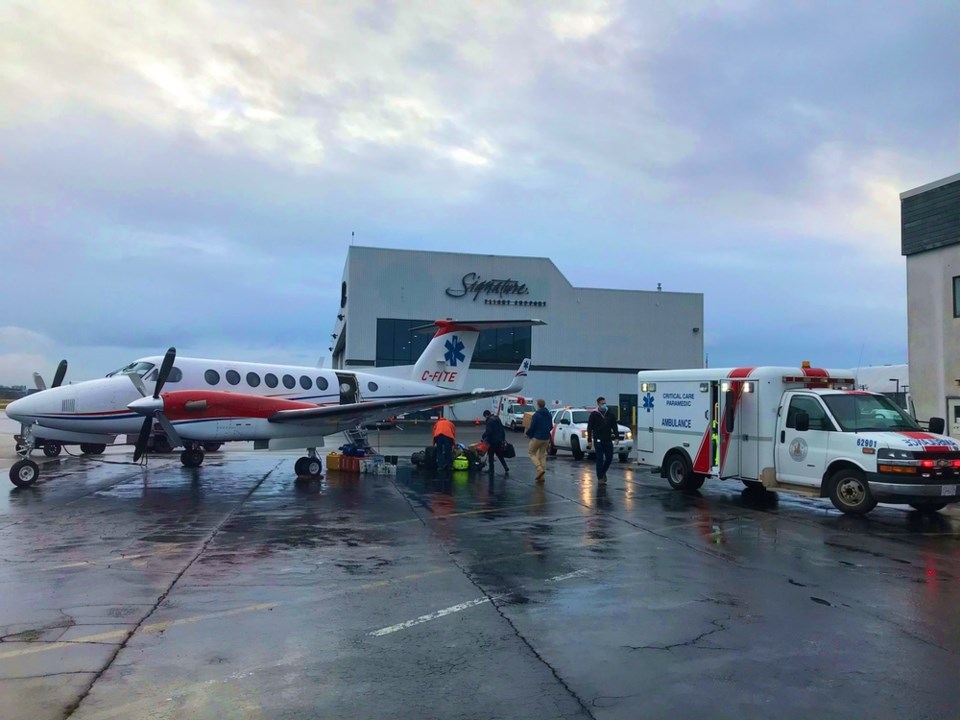The 1,500-person town of Fort St. James was in crisis when Tom Zajac got a call on the night of Dec. 8.
Coronavirus cases were surging in the small community located in the near geographical centre of British Columbia.
“The small hospital and ambulance crew were being overwhelmed by the volume of the cases,” Zajac remembers hearing over the phone at his home in Anmore.
A FLYING PARAMEDIC
In his spare time, the Tri-City resident leads Coquitlam Search and Rescue, but by day, Zajac works as a critical care paramedic, with the highest level of training available in B.C.
On a normal day, Zajac pulls in to YVR before getting lifted off in a helicopter or fixed-wing aircraft, headed literally anywhere in the province. His job is to keep people alive and healthy en route from rural B.C. to the big hospitals of Kelowna, Kamloops, Vancouver and Victoria.
Bringing the virus home to his two children is always in the back of his mind, he said, something that keeps him vigilant when he masks up and sterilizes equipment and aircraft at the end of a flight.
“Across the province, we’re seeing a volume that essentially any patient could be a carrier, and we’re already transferring a large volume of confirmed positive cases on a day-to-day basis anyway,” said Zajac, adding his COVID-19 patients have peaked with the pandemic in B.C., first in the spring and again now.
But this time was different.
'THE HOSPITAL WAS OVERRUN'
Fort St. James's team of just under a dozen paramedics had been running non-stop for weeks in a rural area that’s so spread out it can take up to four hours to respond to a 911 call.
In any given month, the paramedics receive between 50 and 60 calls. Before Zajac arrived, that had ballooned to 33 calls in six days.
“The hospital was overrun in Fort St. James and they just had no capacity to keep those patients,” said Zajac, who by the next morning was getting set to join a four-person paramedic rapid response team sent by BC Emergency Health Services under the province’s surge plan.
The morning of Dec. 9, Zajac and the other three paramedics, loaded up a small airplane with their standard kit of bulky supplies: cardiac monitors, ventilators, medications, medication pumps — or as the Anmore resident put it, “Essentially, what we have is equipment for a portable ICU.”
When they arrived at the small airport in Fort St. James, they were slated to be put up in the hospital's staff quarters. But with the situation reaching desperate levels, Zajac said the Metro Vancouver team “hit the ground running,” responding to a 911 call before they even made it into town.
Instead of flying in helicopters and airplanes, they were tasked with caring for patients for the six to seven hours return trip from the town’s hospital to Prince George, where Northern Health had set up a COVID-19 ward for the region.
Over the next four days, the four-person crew ran laps between the two hospitals, trying to stagger themselves, trying to take the pressure off local paramedics and hospital staff. Still, workdays often ran well over 12 hours.
“I don’t think you can keep that up for very long and that’s what those local crews were facing,” said Zajac. “They were facing several long days and fatigue was becoming an issue for them."
'SAME CAN HAPPEN IN ANY CITY'
On Dec. 13, the rapid response team flew out, replaced by another crew who, in turn, finished its deployment Wednesday, Dec. 16.
In an email to the Tri-City News, BCEHS spokesperson Sarah Morris confirmed the rapid response team's eight-day deployment was standing down after more than 100 calls.
Morris said BC Ambulance is monitoring the status of the local outbreak and has sent another ambulance and an additional two paramedics from Vancouver Island until Dec. 24.
Asked what he took from the whole experience, Zajac said it reminded him just how easy the virus can overwhelm a perfectly capable emergency team.
“It overwhelmed the small hospital,” said Zajac. “The same can happen in any city or any place in British Columbia.”
And while a four-person team can form a solid stop-gap in a community of 1,500, that surge response gets a lot more complicated when that hospital reaches the size of his local emergency room at Eagle Ridge Hospital in Port Moody or Royal Columbian Hospital in New Westminster.
“There’s no help coming for that,” he said.



